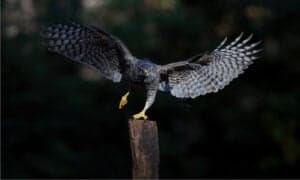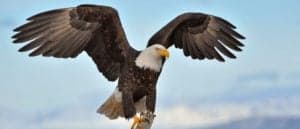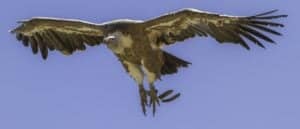Cassowary Attack: Are Cassowaries Dangerous to Humans?
The cassowary is one of the closest living relatives to dinosaurs, and it looks the part. With prehistoric-looking feet and a claw that can reach five inches in length, cassowaries are imposing animals. But how dangerous are they? We’ll dig into past cassowary attacks and decide whether this bird lives up to its title of being “the most dangerous bird in the world!”
A History of Cassowary Bird Attacks
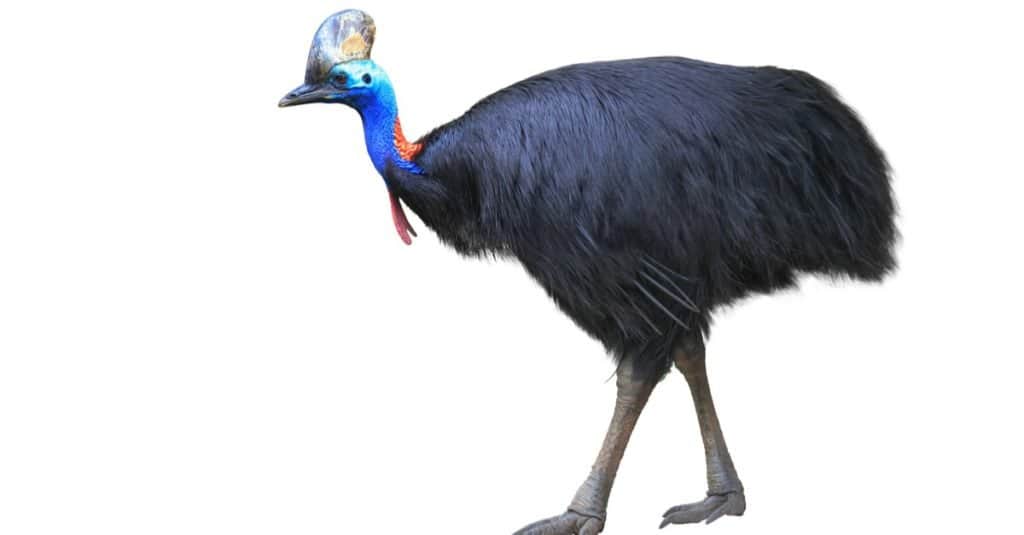
Sanit Fuangnakhon/Shutterstock.com
The most comprehensive study on cassowary bird attacks was published in the Journal of Zoology by Christopher Kofron in 2006.
The main findings were:
- There have been 221 observed cassowary attacks
- 150 were against humans
- 75% of cassowary attacks resulted from humans feeding the birds
- 71% of the time, cassowaries charged. They used their dangerous claws in only 15% of incidents
- 22% of cases were cassowaries defending themselves or eggs, the rest were the result of humans proactively trying to approach the birds
- 7 cassowary attacks (3%) led to serious injuries, a single attack led to a fatality (after this study was completed another cassowary fatality occurred in Florida)
It’s that last bullet point that has led to so much attention. Snakes kill 81,000 to 138,000 people annually from their bites. Crocodiles kill 1,000 people annually. Even hippos kill 500 people a year!
But physical birth deaths are rare. In fact, the ostrich and the cassowary are the only birds worldwide that have caused known physical death to humans! Given that bird attacks that result in fatalities are so rare, let’s examine the two cases where cassowary attacks led to fatality.
Fatal Cassowary Attacks: Australia and Florida
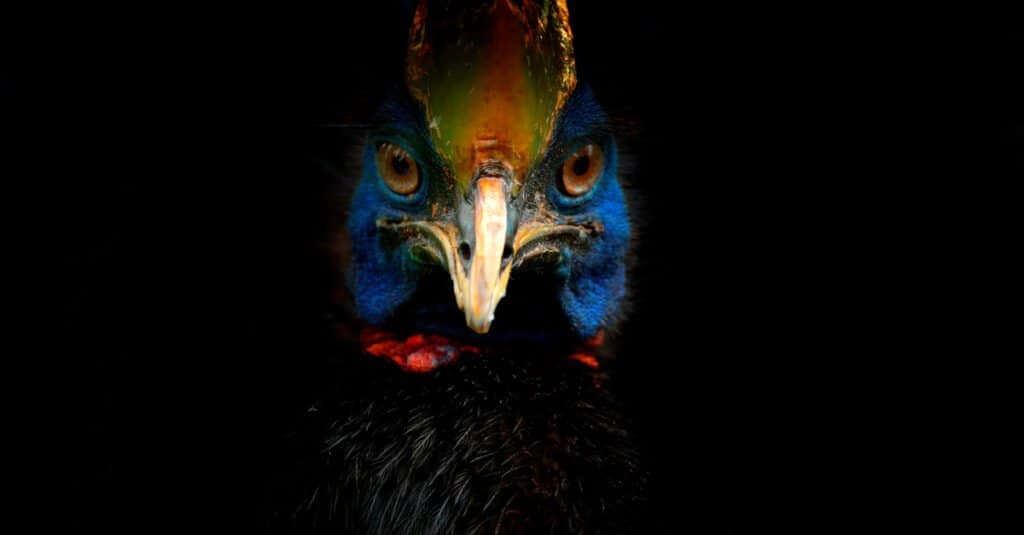
Ondrej Prosicky/Shutterstock.com
The first known cassowary attack that led to death happened in 1926. Two Australian teenagers attacked a cassowary with clubs. After one of the teenagers fell to the ground, the cassowary struck his neck with its large claw that can measure up to 5 inches in length. The cut was large and struck the teenagers jugular vein, and he was unable to survive the attack.
The second cassowary attack that led to death happened in Florida in 2019. A 75 year-old man was keeping a cassowary on his farm. He fell near a fenced area housing the cassowary, but within striking distance of the animal. While he lay on the ground the cassowary struck him more than 12 times, causing deep cuts across most of his upper body. The man was able to call 911, but didn’t survive the attack.
It’s important to remember that cassowaries live in very remote areas. Most cassowary attacks in Australia have occurred around the city of Cairns, the largest city near cassowary populations. In New Guinea they often live in dense forests far from population centers. Native populations report a history of cassowary attacks, so their attacks on humans are likely understated.
Given this, it’s likely the cassowary is the most dangerous bird in the world.
How to Survive a Cassowary Attack
It’s important to remember two things about past cassowary attacks:
- In one case two teenagers were attacking a bird. In the other case an elderly man was keeping it as a pet. Both situations were completely avoidable.
- 75% of cassowary attacks are the birds charging, and most are the result of humans feeding them. Leave cassowaries alone and your odds of being attacked are low.
If you were to encounter a cassowary, keep in mind that they’re easily startled and unpredictable. The best course of action is to slowly back away. Further, you don’t want to be on the ground. Both cassowary deaths occurred after people fell to the ground and were exposed to the large claws of cassowaries. Cassowaries prefer to simply charge and bump, which may hurt but isn’t deadly. If you’re on the ground then you’re suddenly within range of their dagger-like claw.
More from A-Z Animals
The cassowary is one of the closest living relatives to dinosaurs, and it looks the part. With prehistoric-looking feet and a claw that can reach five inches in length, cassowaries are imposing animals. But how dangerous are they? We’ll dig into past cassowary attacks and decide whether this bird lives up to its title of being “the most dangerous bird in the world!”
A History of Cassowary Bird Attacks

Sanit Fuangnakhon/Shutterstock.com
The most comprehensive study on cassowary bird attacks was published in the Journal of Zoology by Christopher Kofron in 2006.
The main findings were:
- There have been 221 observed cassowary attacks
- 150 were against humans
- 75% of cassowary attacks resulted from humans feeding the birds
- 71% of the time, cassowaries charged. They used their dangerous claws in only 15% of incidents
- 22% of cases were cassowaries defending themselves or eggs, the rest were the result of humans proactively trying to approach the birds
- 7 cassowary attacks (3%) led to serious injuries, a single attack led to a fatality (after this study was completed another cassowary fatality occurred in Florida)
It’s that last bullet point that has led to so much attention. Snakes kill 81,000 to 138,000 people annually from their bites. Crocodiles kill 1,000 people annually. Even hippos kill 500 people a year!
But physical birth deaths are rare. In fact, the ostrich and the cassowary are the only birds worldwide that have caused known physical death to humans! Given that bird attacks that result in fatalities are so rare, let’s examine the two cases where cassowary attacks led to fatality.
Fatal Cassowary Attacks: Australia and Florida

Ondrej Prosicky/Shutterstock.com
The first known cassowary attack that led to death happened in 1926. Two Australian teenagers attacked a cassowary with clubs. After one of the teenagers fell to the ground, the cassowary struck his neck with its large claw that can measure up to 5 inches in length. The cut was large and struck the teenagers jugular vein, and he was unable to survive the attack.
The second cassowary attack that led to death happened in Florida in 2019. A 75 year-old man was keeping a cassowary on his farm. He fell near a fenced area housing the cassowary, but within striking distance of the animal. While he lay on the ground the cassowary struck him more than 12 times, causing deep cuts across most of his upper body. The man was able to call 911, but didn’t survive the attack.
It’s important to remember that cassowaries live in very remote areas. Most cassowary attacks in Australia have occurred around the city of Cairns, the largest city near cassowary populations. In New Guinea they often live in dense forests far from population centers. Native populations report a history of cassowary attacks, so their attacks on humans are likely understated.
Given this, it’s likely the cassowary is the most dangerous bird in the world.
How to Survive a Cassowary Attack
It’s important to remember two things about past cassowary attacks:
- In one case two teenagers were attacking a bird. In the other case an elderly man was keeping it as a pet. Both situations were completely avoidable.
- 75% of cassowary attacks are the birds charging, and most are the result of humans feeding them. Leave cassowaries alone and your odds of being attacked are low.
If you were to encounter a cassowary, keep in mind that they’re easily startled and unpredictable. The best course of action is to slowly back away. Further, you don’t want to be on the ground. Both cassowary deaths occurred after people fell to the ground and were exposed to the large claws of cassowaries. Cassowaries prefer to simply charge and bump, which may hurt but isn’t deadly. If you’re on the ground then you’re suddenly within range of their dagger-like claw.



